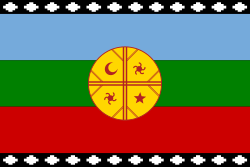Coordinadora Arauco-Malleco
| Coordinadora Arauco Malleco | |
|---|---|
| Participant in the Mapuche conflict | |
 Emblem used by the Organos de Resistencia Territorial (military arm) in sabotage actions awarded by the CAM. The image represents a guemil (symbol of Mapuche iconography) with a Mapuche clava inside it. | |
| Active | 1998–present |
| Ideology | |
| Political position | Far-left |
| Leaders | Héctor Llaitul, Celestino Cordova, Ramón Llanquileo and José Huenchunao[1] |
| Headquarters | La Araucania Region |
| Opponents | |
Coordinadora Arauco-Malleco (CAM) is a Mapuche organization dedicated to, what they call, the revindication and recovery of former Mapuche lands. It was founded in 1998, in Tranaquepe, Chile, and is responsible for land occupation in the zones of Tirúa, Contulmo, Cañete and Temucuicui. Protesters from Mapuche communities have used these tactics against multinational forestry corporations and private individuals.
Several of its members have been judged under anti-terrorist laws left from the Pinochet era because of their violent behaviors. CAM arose from the Mapuche conflict that was revitalized in the late 1990s with the rise of ecologism, and the revindication of indigenismo by politicians of the Concertación. The land rights claimed by CAM can in many cases be traced back to the Occupation of Araucanía in the 1870s and 1880s a period during which many chileans and foreign settlers acquired lands in Araucanía.
2009 actions and controversy
On the morning of August 12 of 2009, it is alleged by Chilean officials that about 80 Mapuches entered the country estate San Sebastián, located between Collipulli and Angol, and occupied it. The occupation was made in response to their unanswered request to buy the San Sebastián estate by authorities. Sergio González Jarpa, agriculture businessman and owner of the estate, requested to the court of Angol the ouster of the occupants. Carabineros gathered special forces from Araucanía Region and flew in a GOPE unit from Santiago. The ouster begun at around 14.00. As result one young Mapuche Jaime Mendoza Collio was shot dead and one carabinero was injured in the leg.[2] The leader of Mapuche organization Consejo de Todas las Tierras Aucán Huilcamán strongly condemned the actions of the police and called the killing an extrajudicial execution.[3] Later on the Legal Medical Service of Chile stated that the dead Mapuche had been shot from behind in the back.[4] Investigations by Policía de Investigaciones have shown that the Mapuche who was shot, Jaime Mendoza Collío, did not have remains of gunpowder on his hands as Carabineros had suggested.
The attacks of 2009 again brought the CAM issue to the level of government. The Alianza por Chile claimed that the Concertación governments have not done enough to arrest the authors of the attacks and protect private property. On August 19, Chilean President Michelle Bachelet condemned an incident between minister Edmundo Pérez Yoma (DC) and the opposition deputy Gonzalo Arenas (UDI), where Arenas threw an alleged copy of the pardon of former CAM leader Víctor Ancalaf on Pérez Yoma's face.[5] Victor Ancalaf had served 5 years of a 10-year prison sentence for terrorist crimes, which Ancalaf vehemently denies.
Updates
References
- ↑ http://diario.latercera.com/edicionimpresa/el-pasado-subversivo-de-hector-llaitul-el-lider-de-los-huelguistas/
- ↑ Confirman muerte de comunero mapuche en enfrentamiento con Carabineros Radio Cooperativa
- ↑ Mapuches exigen presencia de obispo Emol
- ↑ SML confirma que comunero mapuche recibió el balazo por la espalda El Mercurio
- ↑ Fuerte rechazo de Bachelet a incidente entre Pérez Yoma y diputado Arenas El Mercurio
